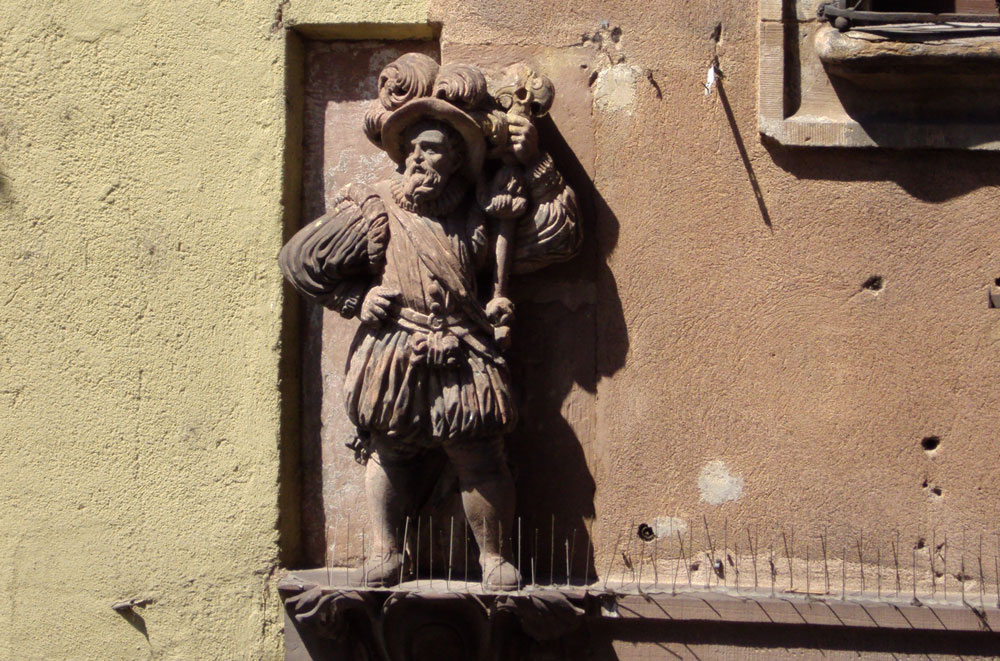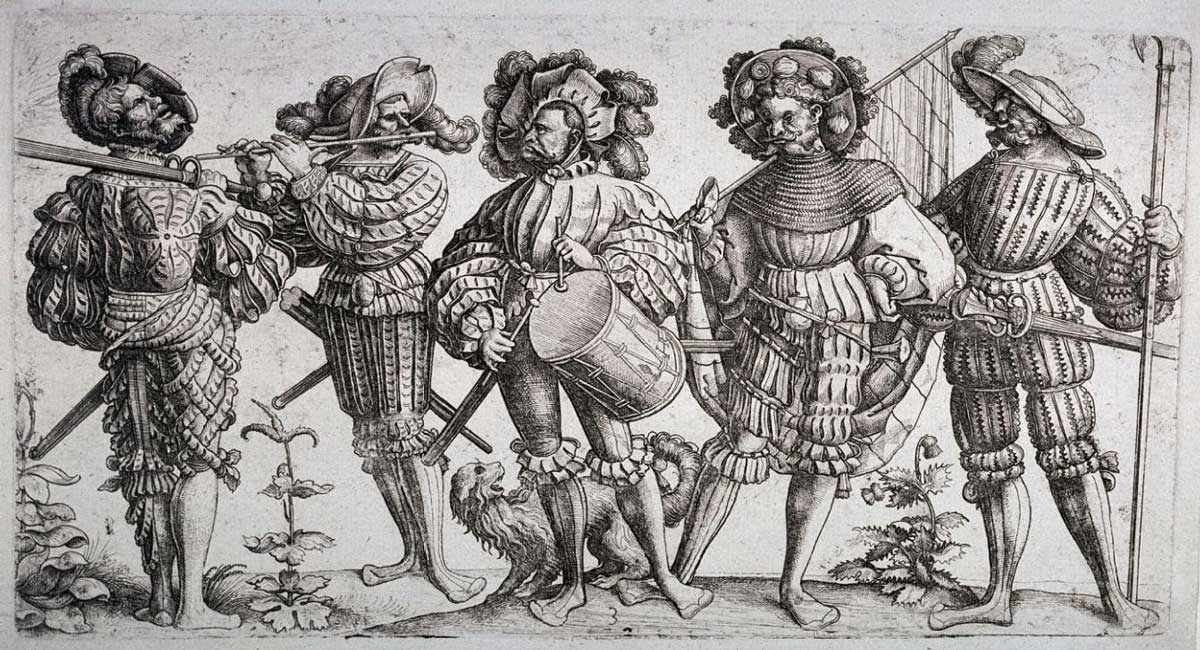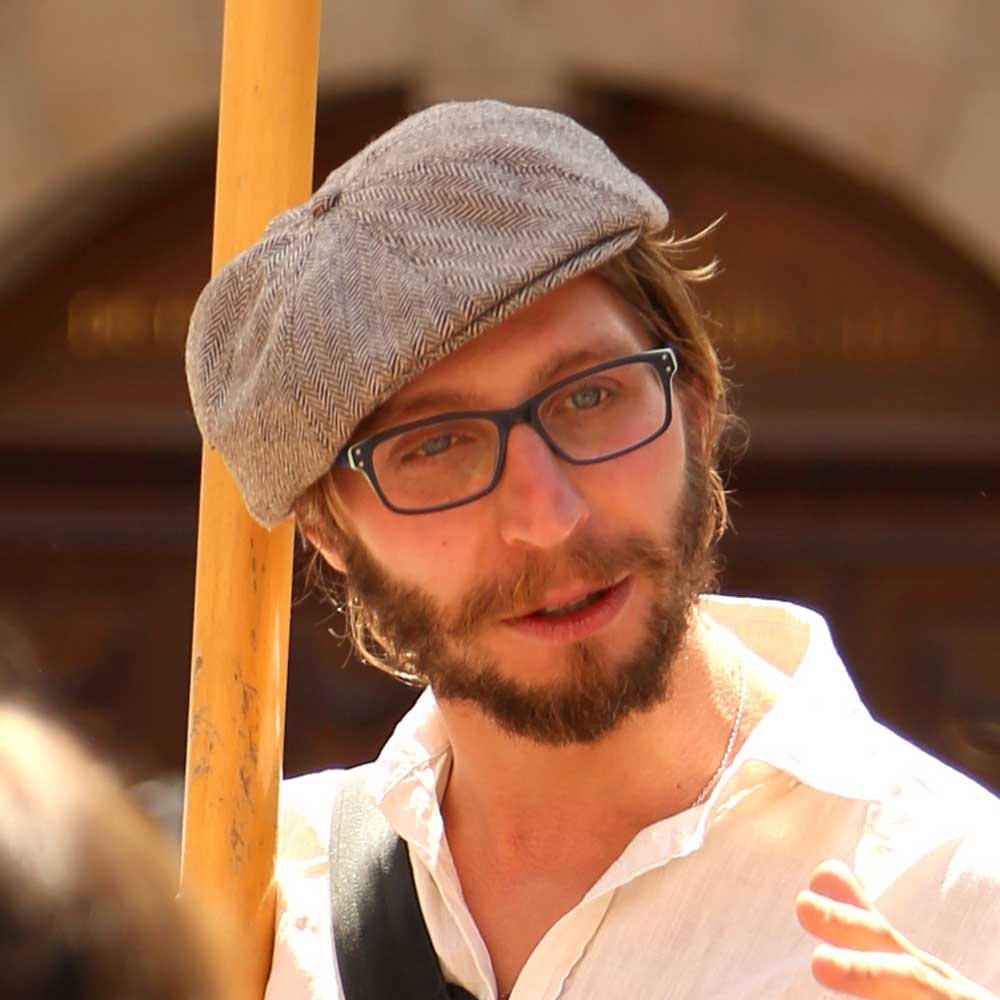The Landsknechte
June 3rd 2020, by Leo
A sharp look, a proud moustache, an assured, slightly arrogant pose : you may have already looked up at the three Landsknechte who guard our beautiful Strasbourg.
The first one still guards the number 7 in rue des Hallebardes (Halberds street), a remnant of a former mansion. The second one still monitors the ancient docks at number 4, quai de la Bruche (Bruche dock). The third stands soberly on the top of the gable of the number 7 of the Faubourg National. Three characters from another time who are not to be swayed by passing crowds. Their behaviour is fit for the Beefeaters of the Tower of London, these red-clad guys with their huge black fur hats, whom one teases as a matter of principle.
This trio of soldiers is similarly dressed in the 16th century style, when their prestige was at its peak. They are the representatives of a soldiery type that already made a name for itself in the 15th century, thanks to its military use of long weapons : the Landsknechte (German for “servant of the land”, which underlines the rural origins of these soldiers).
To their side stands the iconic weapon of these troops : the halberd, a mix between a spear, an axe and a hook in the back aimed at ripping horsemen off their mounts. The first versions had already been anchored in the Chinese military tradition for a long time, but the European version was born in the cantons of the Swiss confederacy, in a time when their neutrality was not yet a given. They needed a weapon that foot soldiers coming from a not noble, motley population could oppose to Royal-blooded cavalry. And here comes the “Helmbarte” (old German Helm, “handle” and Barte, “axe”), that was to be called later on “halberd”, getting popular around the mountains, from Italian Lombardy to the gentle slopes of Rhineland, including of course Alsace and its cities.
To get better acquainted with the image of that weapon which changed the military balance at the time, you should venture in our city’s rue des Hallebardes (Halberds street), close to the cathedral. You will see they still decorate the facades of houses, some of which were already here when the weaponsmiths were forging them on these ground floors.
Or if you feel like taking a closer look at one of these, on a day when you want to avoid rain or to seek some freshness, you may let your feet take you to Strasbourg’s historical museum. There you will find a nice collection of such weapons.
Back to our Landsknechte, those soldiers who distinguished themselves with their ability to face infantry as well as cavalry. The term ended up defining more specifically troops of mercenaries, usually German, who got hired pretty much everywhere for their bloody efficiency, a military answer to the Swiss pikemen who started the trend. Of course, the halberd was not their only companion : they were armed mostly with 6 meters-long pikes, while the richest and most able of them had arquebuses and even Zweihänders (long two-handed swords, that one sees well in the hands of a renderer).
In passing and for the sake of detail, if you look well enough at our two Strasburgers guards, you may notice their puffed-out clothes seem to offer an especially light protection. According to them, their particular choice of weapon justified such a sacrifice of protection in favor of mobility. It is easy to imagine the competition in ostentatious clothing in a troop where it tells about fighting skills.
To come back to our three stone-serious Landsknechte, their presence is no coincidence. The first, on the Bruche dock, decorates an ancient inn, “Zuom Dreibel” (old German for “At Grapes’s ”) a place where you can still quench your thirst and which is now called “At the Footman’s”, maybe as a reference to the ancient guardian. When the statue appeared, those docks were still a toll station at the Ill river’s entrance. Such blazing uniforms strolling about the docks were a common sight, either that they were here for the penny’s glory and its protection as it got collected, or that they were just passing by on their way to other shores. Not to forget about the boatmen, who would readily employ some of them here or to accompany them on distant rivers that were far from being as safe as they are nowadays.
For the second one, in Halberd street, the self-evident street name is striking: what can be more natural for a weaponsmith than to solicit the clients with a nice statue showing the casual class you are entitled to if you are to buy a blade here ?
The third one has found his place long before today’s building itself, when the place was occupied by the “Zunfthaus”, the headquarters of the gardeners’ guild, built around 1600. A symbol of power, probably to remind everyone that, even poor, the gardeners had the “droit de bourgeoisie” (full citizenship), the right to vote and to fully participate to the city’s life.
Discreetly visible, our soldiers still look at us from their aged perches. Yet they are not alone! A witness from a different time is in town and you could very well go say “Hi” to him: it is the Homme de Fer (Iron Man), whose story Matthias tells you in another article. Or maybe you would like to know more, now that I have set the bait ? Then come to our guided tours and discover the fascinating world of the still beings who populate Strasbourg’s facades!
Read also : The Anchor corporation (the boatmen)
Read also : Uncommon signs, The Iron Man and The Crocodile





